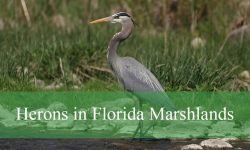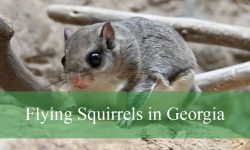North America is home to a diverse range of red bird species, many of which can be found throughout the United States. Their striking red plumage serves various purposes, from attracting mates to blending into their natural surroundings. While some of these birds are native to dense forests, wetlands, and open grasslands, others are commonly spotted in suburban areas and backyard feeders.
This guide highlights 35 red bird species primarily found in North America, with a focus on those residing in the U.S. Each species is detailed with key identification traits, habitat preferences, and distribution, helping birdwatchers and nature enthusiasts recognize these vibrant birds in the wild.
Different Types of Red Birds
House Finch
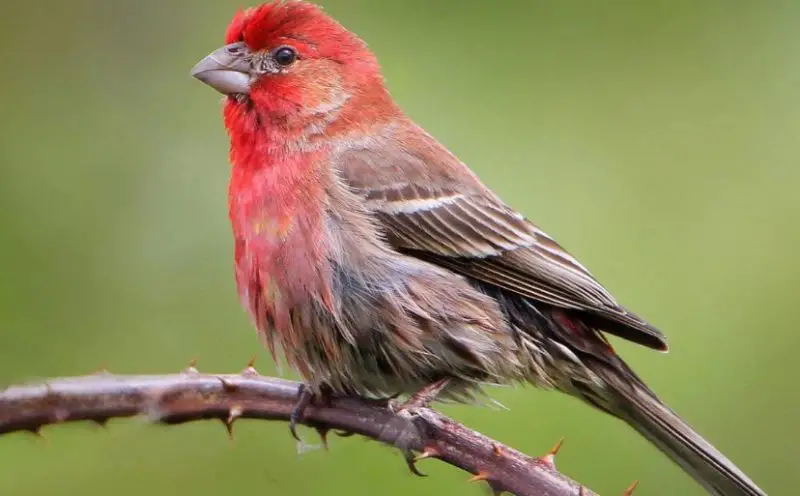
House Finches (Haemorhous mexicanus) are among the most common urban birds in North America, easily identified by their red plumage.
Males feature a red head and a reddish chest, occasionally extending to the lower belly. Females, on the other hand, lack red coloring and instead exhibit streaked brown plumage.
These birds are highly adaptable, thriving in cities and suburban areas. In colder Northern regions, House Finches migrate south during winter. They are commonly found in Southern Canada, the United States, and Mexico, with a vivid red plumage nuance.
Cinnamon Teal
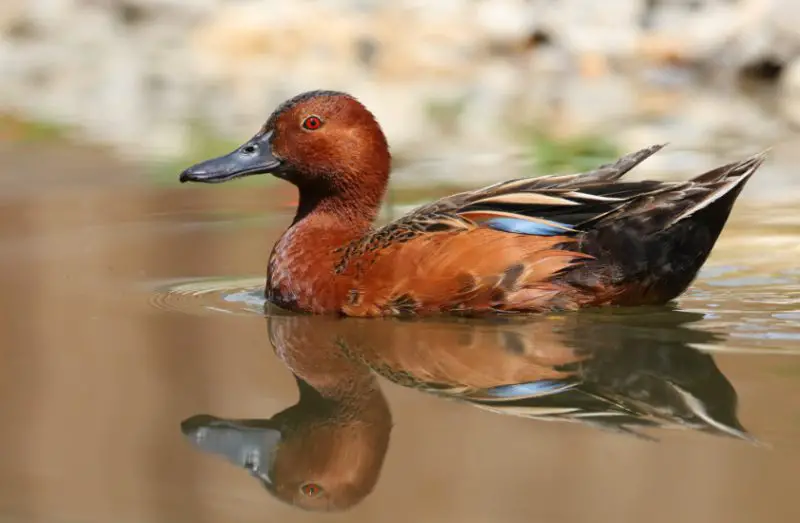
Cinnamon Teal ducks (Spatula cyanoptera) are recognized for their distinct cinnamon-red plumage, which is specific to males. Their heads and necks exhibit a brighter red shade, while the rest of their feathers take on a darker cinnamon hue.
Females, in contrast, are dull brown and can appear to be an entirely different species. These birds are commonly found around ponds and lakes in the Western United States but migrate further south to regions like the Caribbean and South America. California and Arizona serve as important stopover points during their overwintering migration, with red and brown-red plumage nuances.
Purple Finch
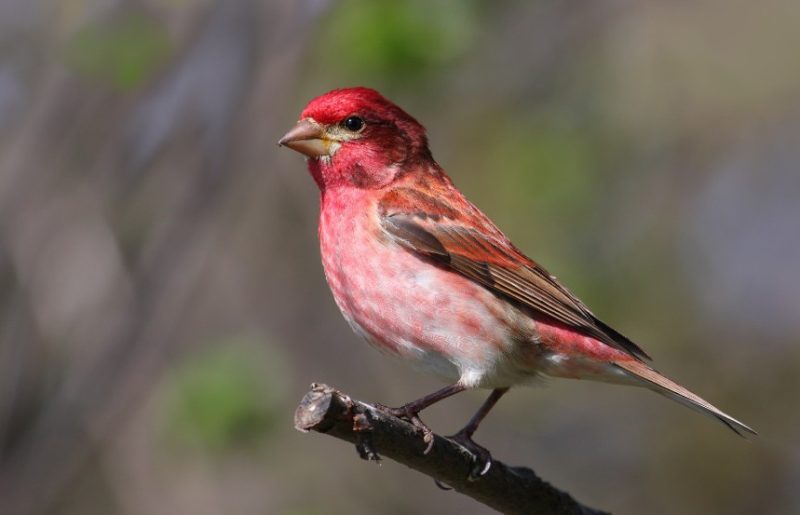
Purple Finches (Haemorhous purpureus) display clear sexual dimorphism, with males showcasing a vivid raspberry-red hue, especially on their heads and necks. Their chest and lower belly also feature bright red tones, while their wings remain dark with faint red undertones.
Females, on the other hand, have a streaked brown appearance. These birds are known for their swift and agile flight, often making quick directional changes. They primarily inhabit Canada, the Eastern and Western United States, Central America, and Cuba, displaying a raspberry-red plumage nuance.
Pine Grosbeak
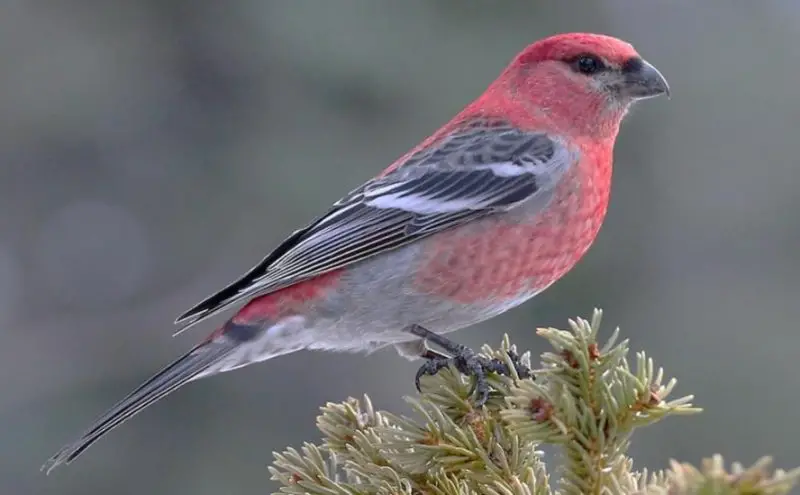
Pine Grosbeaks (Pinicola enucleator) are large, slow-moving birds that follow food sources, particularly fruit-bearing trees. Males exhibit pink-red and rust-red hues, while females are mostly gray with black wings.
These birds are abundant in sub-Arctic regions but may be absent from certain areas in specific years due to food scarcity. During the winter, Pine Grosbeaks rely heavily on fruit and are commonly found in Canada, Alaska, and the Northern United States, as well as parts of Scandinavia and Siberia, with a rose-red and rust-red plumage nuance.
Hepatic Tanager
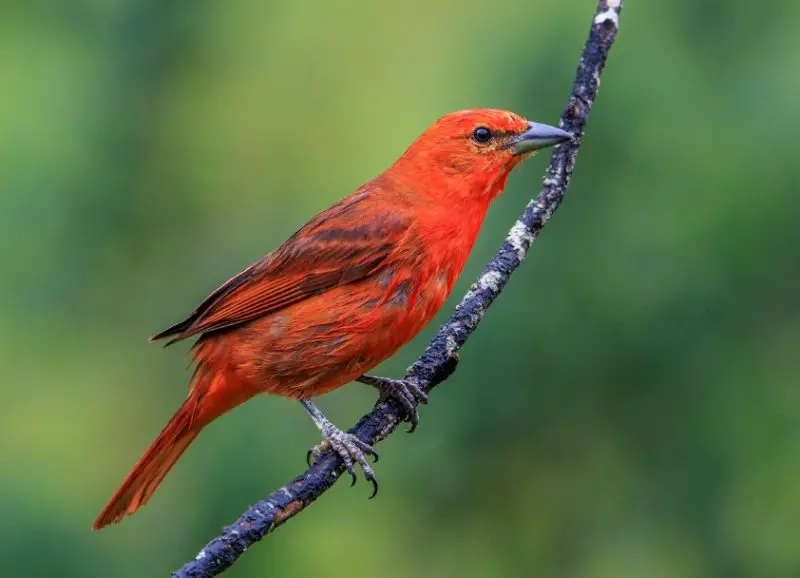
Hepatic Tanagers (Piranga flava) are known for the bright red coloration of their males, which extends across their head, underbelly, and shoulders. Their wings, however, contain a mix of red and black feathers.
Females have a distinct yellow-olive plumage, making them easily distinguishable from the males. These birds are not widespread in North America but can occasionally be seen in Arizona and remote areas of Southern California. While some populations in Central America migrate, most remain resident throughout the Americas. They are found in Arizona, New Mexico, California, Central America, and South America, exhibiting a bright red plumage nuance.
White-winged Crossbill
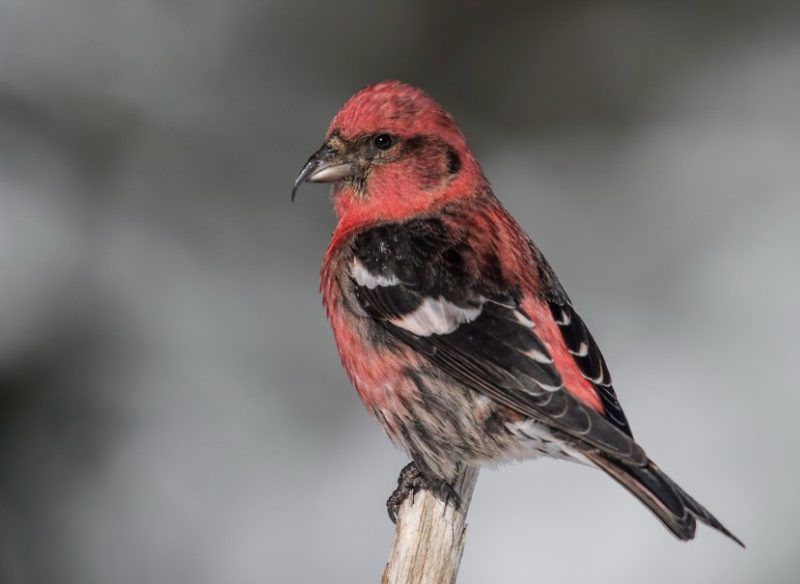
The White-winged Crossbill (Loxia leucoptera) stands out due to its unique crossed bill, which is specially adapted for feeding on conifer cones. Males are recognized by their pale red plumage, covering their head, chest, and back, with black and white accents on their wings.
Females, in contrast, have an olive, yellow, and black appearance, lacking the red plumage seen in males. These birds are highly adapted to northern climates and are primarily found in the Northern United States, Canada, Alaska, and Northern Europe, displaying a pale red plumage nuance.
Red Phalarope

Red Phalaropes (Phalaropus fulicarius) are seabirds found along the coastal regions of the United States, Canada, Greenland, Iceland, and Europe. Typically gray and white, males develop a striking red-brown underside during the breeding season, often compared to the color of a rotten tomato. Their crowns turn black, further distinguishing them from their usual appearance.
Females also change colors, though they retain a mix of tan, black, and white. These birds thrive in Arctic waters, where their seasonal color transformation helps them blend into their environment.
ʻApapane
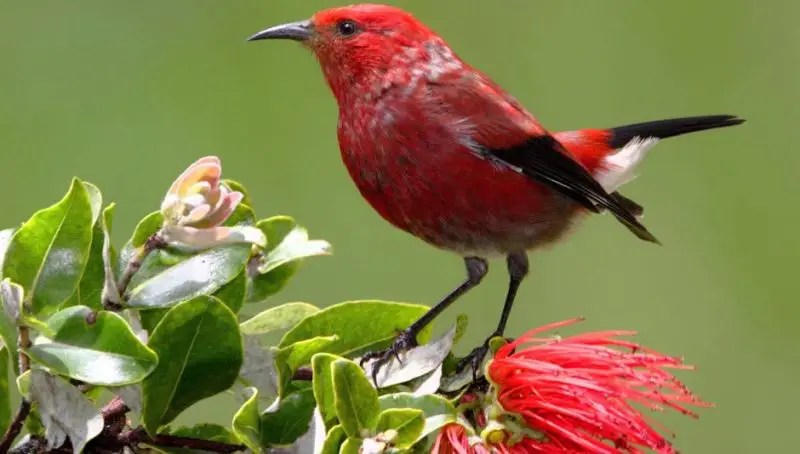
The ‘Apapane (Himatione sanguinea) is a bright red songbird native to Hawaii. With vivid red plumage covering its head, belly, and base wings, it contrasts beautifully with its black-tipped wings and small white patches on the lower belly and ventral tail.
Juveniles are duller, displaying gray and brown tones before maturing. As a nectar-feeding bird, the ‘Apapane plays a crucial role in pollination, hopping between tree branches in search of flowers. Found in the treetops of Hawaiian forests, this species is an important part of the island’s ecosystem.
Northern Cardinal
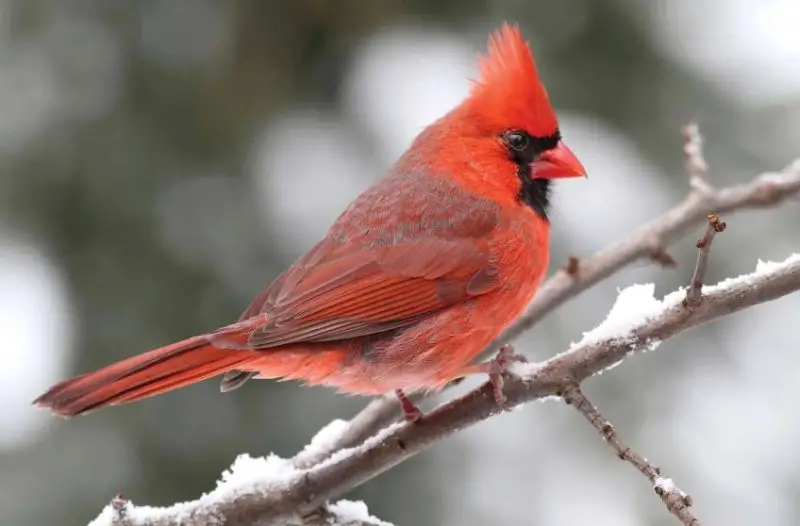
One of the most common red birds in North America, the Northern Cardinal (Cardinalis cardinalis) is widely spread across Eastern North America.
This species showcases striking red plumage due to its diet, which is rich in carotenoids. Males metabolize these pigments to develop a bright red coloration, while some rare individuals may turn yellow.
The Northern Cardinal’s black facial mask contrasts with its red feathers, making it easily recognizable. Males are known for their courtship behavior, often feeding seeds to females.
These birds are year-round residents in their range and have expanded into Northern territories due to seed availability, primarily found in the Eastern and Southern United States and Eastern Central America, with a bright red plumage nuance.
Vermilion Flycatcher
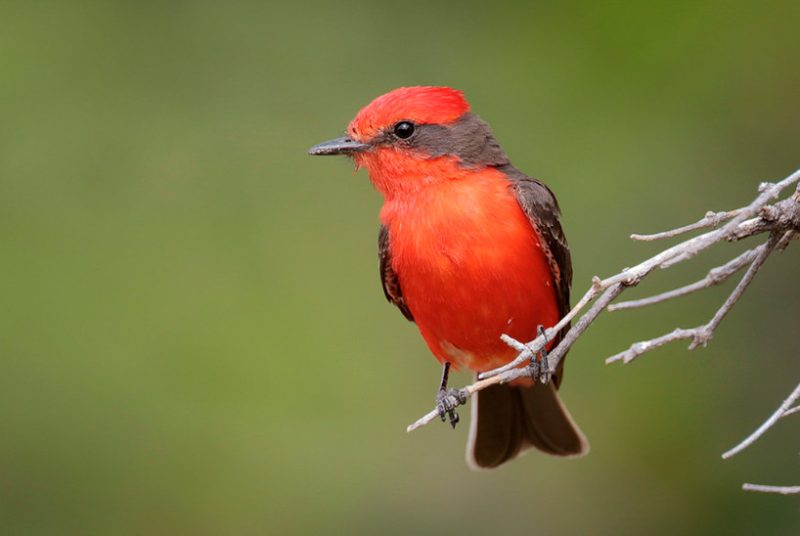
The Vermilion Flycatcher (Pyrocephalus rubinus) is named after its deep vermilion-red plumage, which resembles the historic cinnabar pigment.
Males of this species feature a vivid red head, chest, and belly, contrasted by black wings. Their striking color makes them easy to identify in their natural habitat.
Vermilion Flycatchers prefer riparian areas—regions with abundant vegetation near water sources. Though found in the U.S., they are more commonly spotted near the Mexico border.
This species is sometimes referred to as the “Fire Head” due to its bold coloration and is primarily found in the Southern United States, Central America, and Northern South America, displaying a vermilion-red plumage nuance.
Summer Tanager
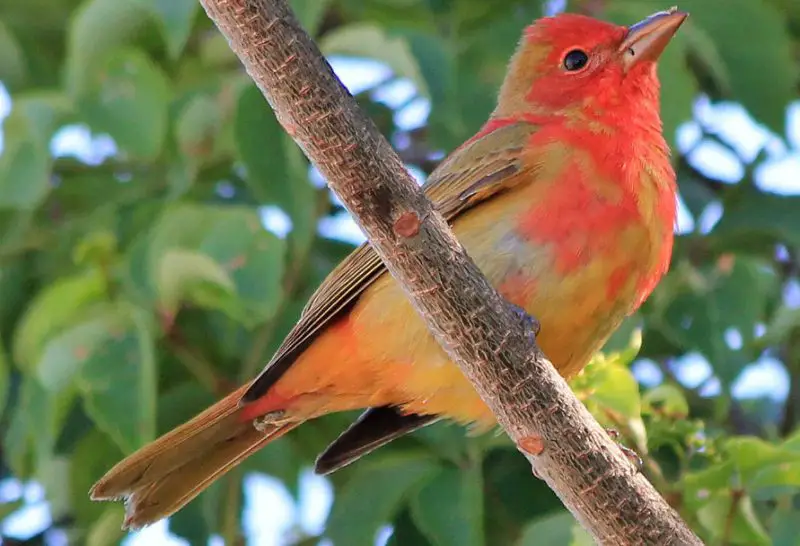
The Summer Tanager (Piranga rubra), also known as the “Summer Red,” is a seasonal visitor to North America, displaying vibrant red plumage.
Males are completely red, with varying shades across their bodies—darker red on the wings and bright red on the head and belly. Females, in contrast, are yellow.
These birds are often found in the Southern United States, particularly around oak trees, where they hunt insects such as bees and wasps. They are primarily distributed across the Southern and Southeastern United States, Central America, and Northern South America, with a plumage that ranges from pale red to vivid red.
Crimson-backed Tanager
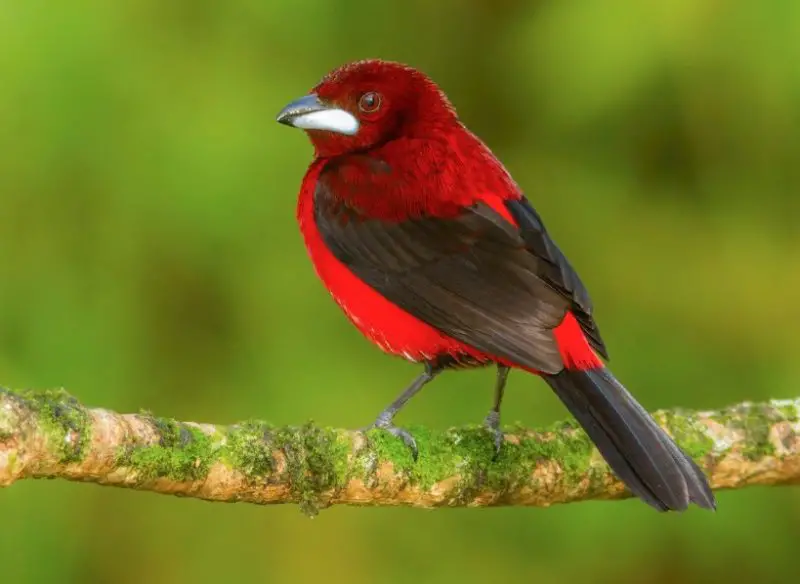
Crimson-backed Tanagers (Ramphocelus dimidiatus), found in Colombia, Venezuela, and Panama, are medium-sized songbirds measuring up to 7.1 inches. Males boast deep crimson-red plumage covering their heads, bellies, and wings, with a contrasting black tail and a white beak.
Females, in contrast, have tan-to-brown plumage, including brown heads and underbellies, though they share the same bright beak as males. These birds prefer tropical forests and are typically seen alone or in small groups.
Red-throated Ant-Tanager
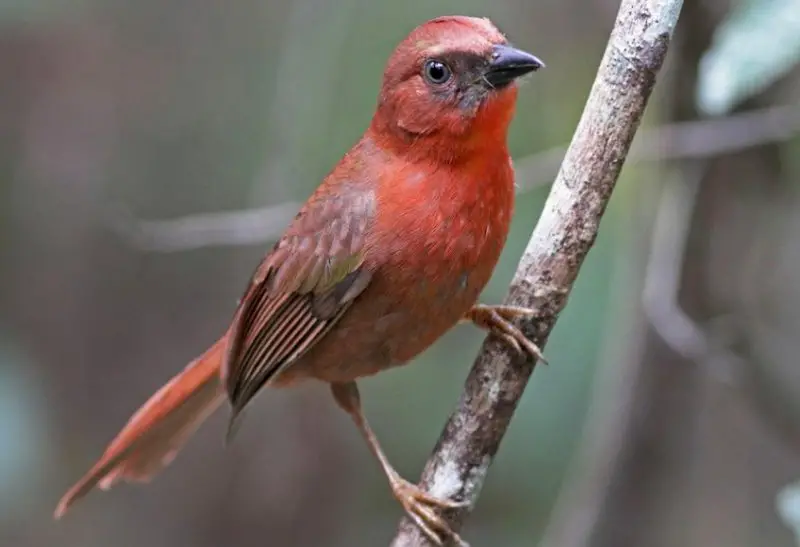
The Red-throated Ant-Tanager (Habia fuscicauda) is a bright red bird found in Mexico, Venezuela, and Colombia. Males have red heads, red underbellies, and red wings, with a black facial mask. Females lack red coloration, instead showing yellow-olive plumage.
Primarily insectivores, these birds favor feeding on ant colonies, often foraging in lowland forests. However, they are also known to explore elevations of up to 2,000 feet in search of food, making them versatile members of tropical ecosystems.
Red-billed Firefinch
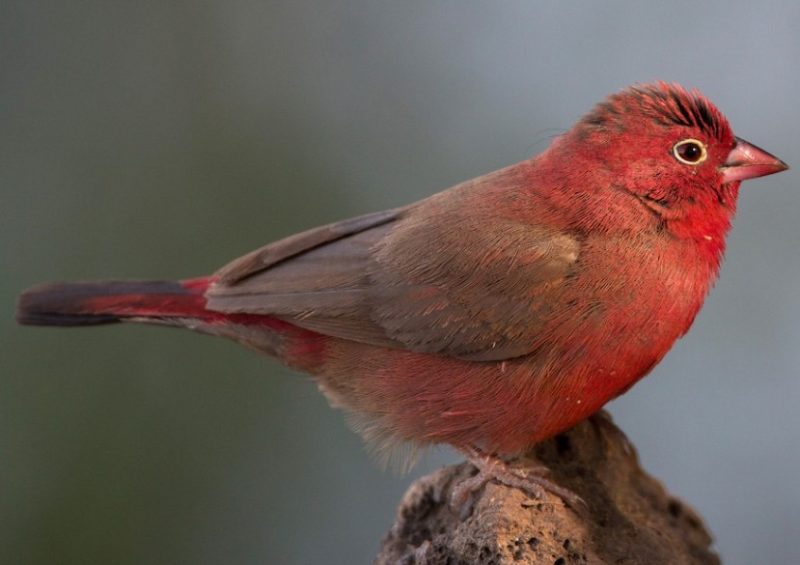
The Red-billed Firefinch (Lagonosticta senegala) is one of the smallest red birds, reaching only 3.9 inches in size. Males are covered in scarlet-red plumage, with a pale red beak and red-black wings, while females have dull gray-brown bodies with small red patches on the head and tail. These birds are primarily seed eaters and are often found in open woodlands, grasslands, and near human settlements across sub-Saharan Africa.
During the breeding season, Red-billed Firefinches build small, dome-shaped nests where they lay multiple white eggs. They are social birds, often seen foraging in pairs or small groups. Their adaptability and striking coloration have also led to their introduction in some non-native regions.
Andean Cock-of-the-Rock
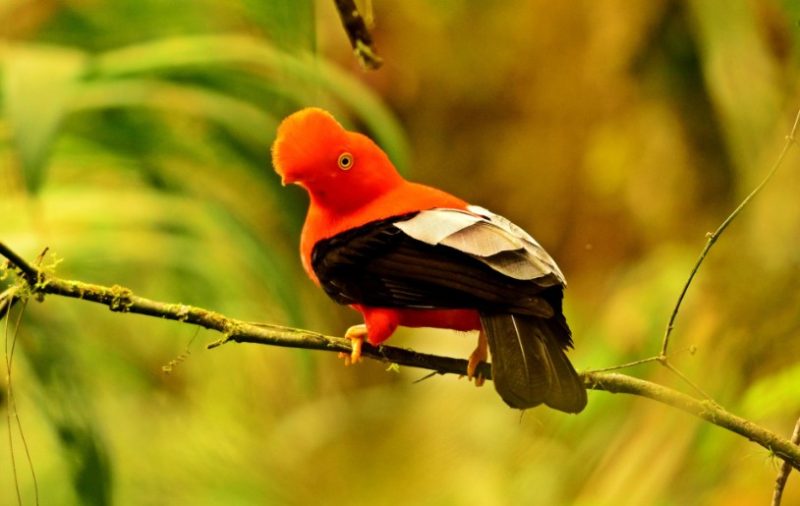
The Andean Cock-of-the-Rock (Rupicola peruvianus) is a striking bird found in the tropical forests of the Andes in Colombia, Ecuador, Peru, and Bolivia. Males have a bright red or orange head, crest, and underbelly, while their wings and tails are black and gray. Their most distinctive feature is their large, disc-like crest, which plays a crucial role in courtship displays. Females, on the other hand, are duller, with a brown-red body and dark red wings and tails.
These birds primarily feed on fruits and insects, playing a vital role in seed dispersal within their habitat. They are known for their elaborate mating rituals, where males gather in communal display areas called leks to attract females. Preferring dense, humid forests near rocky cliffs, they are often seen at elevations ranging from 1,500 to 7,900 feet.
Brazilian Tanager
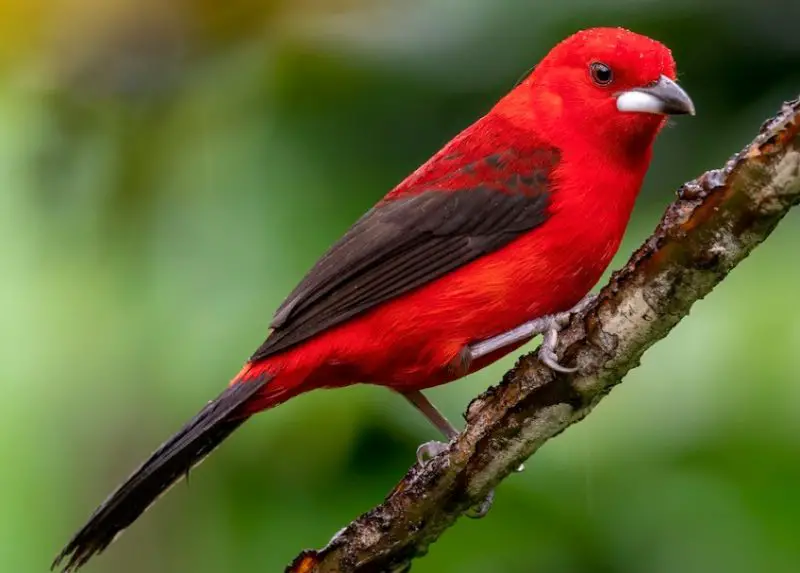
The Brazilian Tanager (Ramphocelus bresilius) is a vibrant species native to the coastal scrubs and forests of Brazil. Males have crimson-red plumage with black wings, a long black tail, and a red-and-white beak. Females, in contrast, are mostly brown with orange-red underbellies and brown tails. These birds thrive in humid tropical regions, often spotted in pairs or small groups foraging for fruit and seeds.
During the breeding season, females build small cup-like nests where they lay green-blue eggs. Their melodious songs and striking colors make them a favorite among bird watchers. Though commonly found in the wild, they are also frequently seen in urban gardens and parks.
Crimson Finch
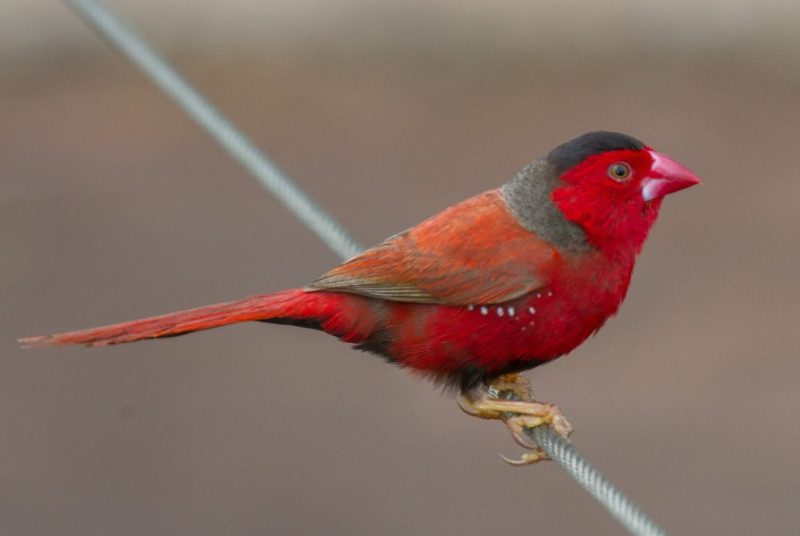
The Crimson Finch (Neochmia phaeton) is a small, striking bird native to Northern Australia and New Guinea. Males display a crimson-red head, underbelly, and tail, with dark red wings and a black upper back. Females, though smaller, also show red coloring on the face and bill, but their underbellies are mostly pale gray. These birds prefer tropical forests, wetlands, and areas with pandanus trees.
Highly territorial, male Crimson Finches can be aggressive, particularly in captivity, where they require large enclosures. In the wild, they are often seen in small flocks, moving between dense vegetation and open areas in search of grass seeds and insects. Their vivid colors make them popular among bird enthusiasts.
Northern Carmine Bee-Eater
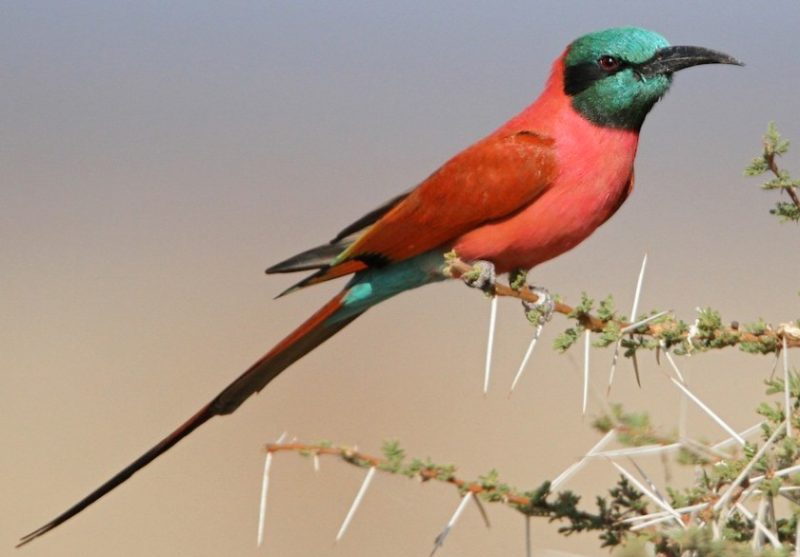
The Northern Carmine Bee-Eater (Merops nubicus) is a striking bird native to sub-Saharan Africa, known for its carmine-red body and iridescent green-blue head. Its black mask extends from the beak to the back of the head, contrasting with its long black tail and wings. This species thrives in open savannas and near water sources, often perching on large animals like buffalo or elephants to catch insects.
A highly social species, Northern Carmine Bee-Eaters nest in colonies, burrowing into sandy riverbanks. Their diet consists mainly of bees and other flying insects, which they catch mid-air with remarkable agility. Their loud, rasp-like calls are a common sound in their habitat, making them easily recognizable in the wild.
Scarlet Tanager
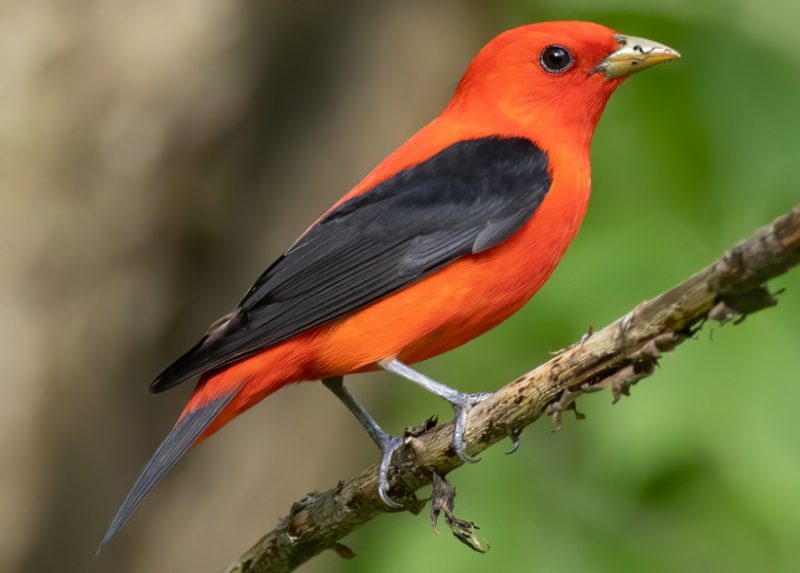
The Scarlet Tanager (Piranga olivacea) is known for its dramatic contrast in appearance. Males turn bright red with black wings during the breeding season, while outside of this period, they shift to an orange-red hue.
Females have an olive-green coloration with subtle reddish tinges on the underbelly. Their color transformation makes them unique among red birds.
These birds migrate between Eastern North America and South America, particularly in Ecuador, Colombia, and Peru, displaying a vivid red plumage nuance.
ʻIʻiwi
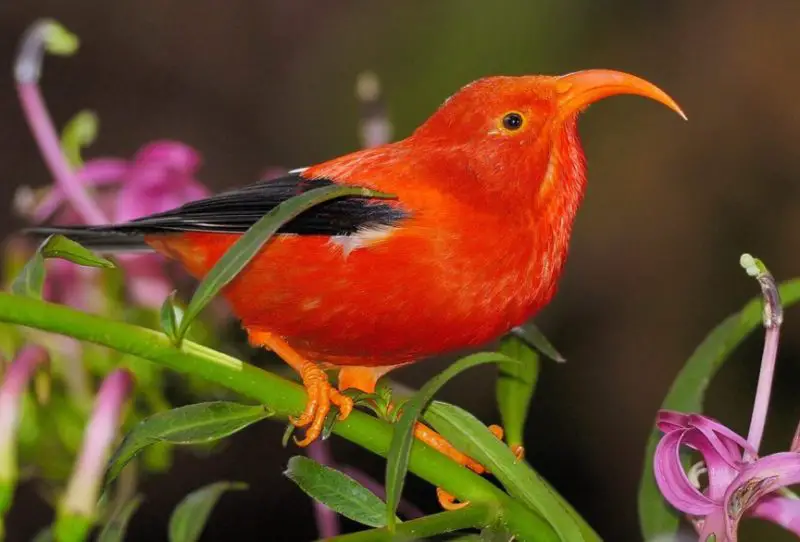
The ‘I’iwi (Drepanis coccinea), another iconic Hawaiian bird, is distinguished by its bright red body, black wings, and a curved orange-red beak. Unlike the ‘Apapane, this species also has red legs, adding to its striking appearance.
These birds thrive in the high-elevation forests of Hawaii, where they continue to be found in large numbers, with an estimated population of nearly half a million. Their specialized beaks make them excellent nectar-feeders, playing a key role in pollination and maintaining the balance of the island’s flora.
American Flamingo
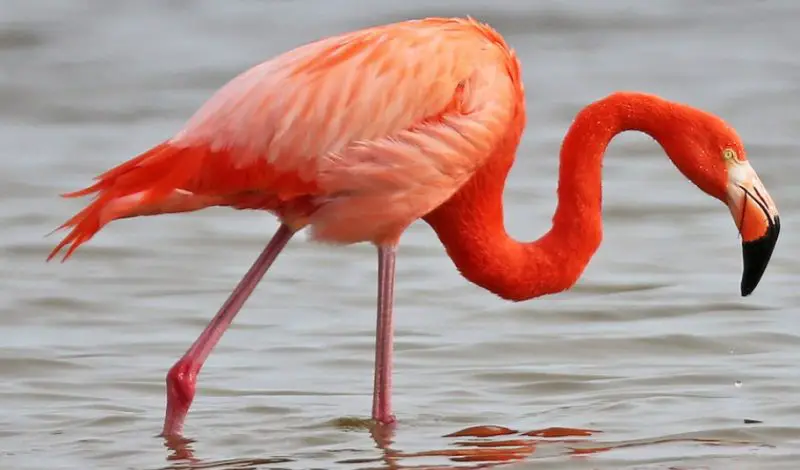
The American Flamingo (Phoenicopterus ruber) is the tallest red bird in the Americas, found in tropical regions such as Florida, the Caribbean, and Central America. Its plumage is a pink-red hue, which varies in intensity based on diet. Unlike many red birds, its wings are often a brighter shade than the rest of its body, creating a beautiful contrast.
With long, thin legs and a curved black-and-white beak, the American Flamingo is a striking sight in wetland habitats. These birds have low reproduction rates, with females typically laying only a single egg per breeding season.
Northern Red Bishop
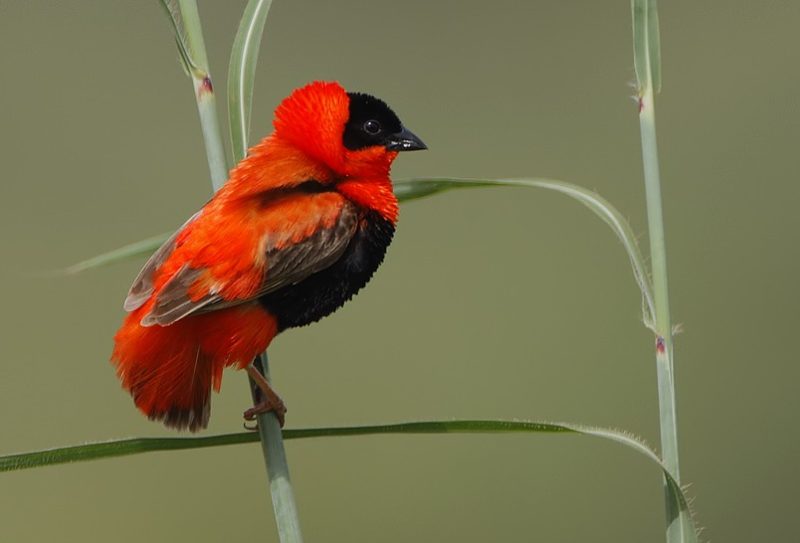
The Northern Red Bishop (Euplectes franciscanus) is a dark red and black bird native to sub-Saharan Africa, with small introduced populations in California and the US Virgin Islands. Males undergo a dramatic transformation during breeding, with their heads and wings turning a deep red, while their faces and bellies remain black.
Found near wetlands, these birds are known for their large, noisy flocks, which can range from a few dozen to several hundred individuals. Their high-pitched calls make them easy to identify, adding to their striking presence in their habitats.
Crimson-collared Grosbeak
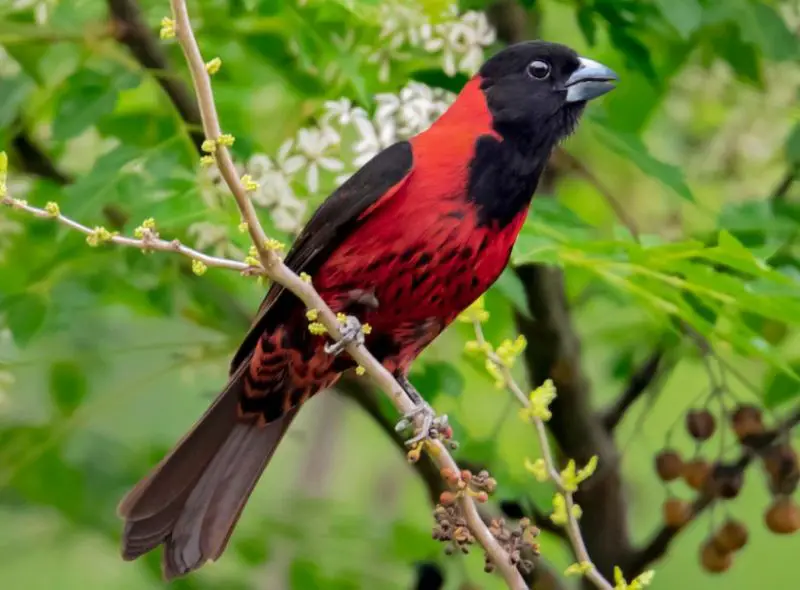
Crimson-collared Grosbeaks (Rhodothraupis celaeno) are native to Southern Texas and Eastern Mexico, named after their deep crimson-red plumage. Males have black heads, a small crest, and a black beak, with their shoulders and underbelly also displaying a rich crimson hue. Their black wings feature subtle red highlights.
Females, in contrast, have olive, gray, and black plumage but share the distinct black face seen in males. This species’ dark red coloration leans toward rust rather than vivid red, making it a unique sight in its habitat.
Flame-colored Tanager
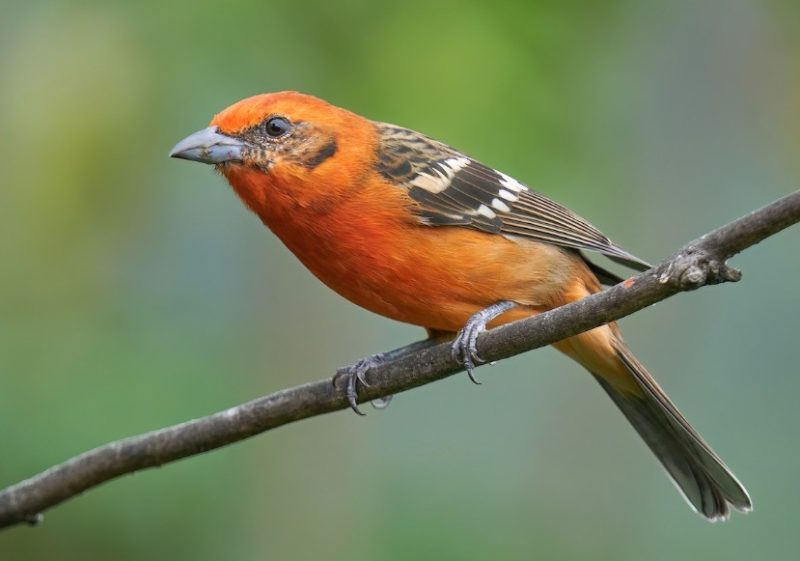
The Flame-colored Tanager (Piranga bidentata) is a striking bird found in Arizona, Texas, and Central America. Males showcase a mix of red, orange, and yellow plumage, with a red-orange head and a yellowish lower underbelly. Their gray-brown wings contrast sharply with the rest of their body.
Females have an olive tone with black wings, featuring some orange-red feathers on the front of their crowns. Both sexes share dark wings with white spots, adding to their distinctive look. This species’ fiery coloration makes it stand out in forested areas.
Red Avadavat
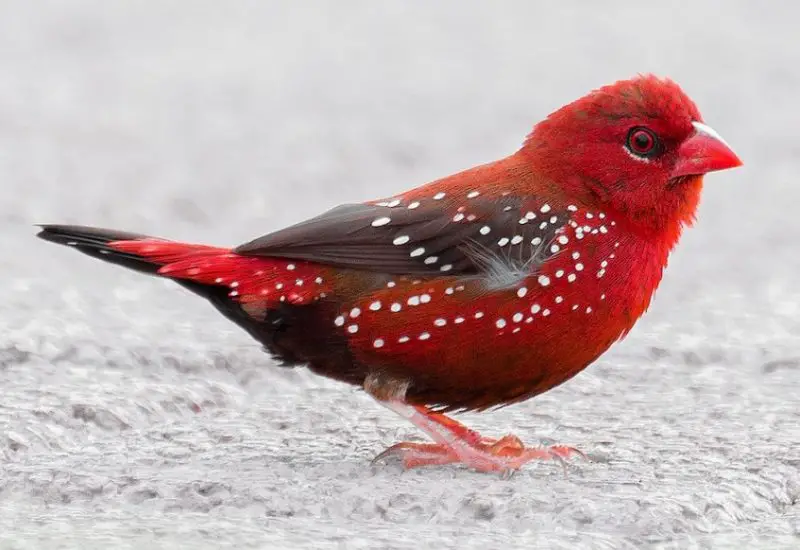
Native to India, Pakistan, Thailand, and Vietnam, the Red Avadavat (Amandava amandava) is a small finch-like bird with a deep red body and a pale red beak. Males display dark red heads with black markings around the eyes, bright red underbellies with white spots, and red-spotted wings.
Females, however, are mostly yellow with gray wings, though they retain the pale red beak and black facial mask seen in males. Interestingly, males shift to a green-dominated appearance outside the breeding season. Their vibrant look has led to their introduction in regions worldwide.
Chestnut Munia
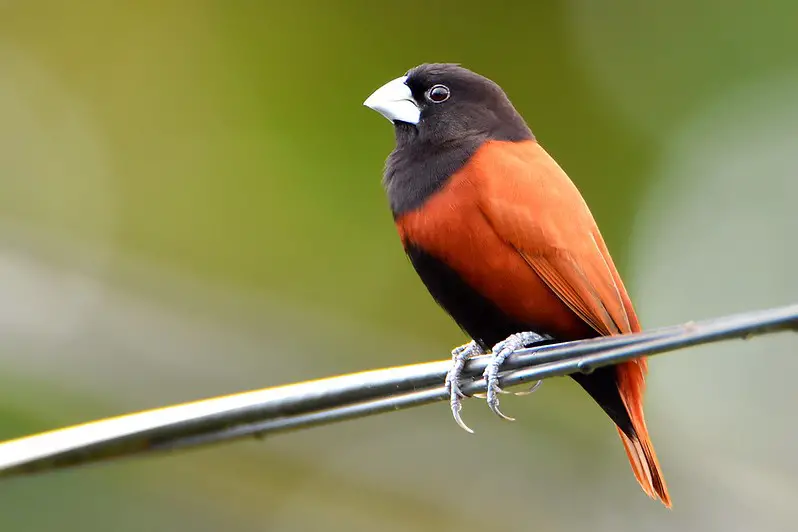
The Chestnut Munia (Lonchura atricapilla), found across Southeast Asia, is known for its unique chestnut-red plumage. These birds have a sharp contrast in coloration, with black heads, white beaks, and a rich chestnut-red hue covering their bellies, wings, and backs.
This distinct coloring has contributed to their introduction in Central and North America, though they are considered a potential risk to crops due to their heavy consumption of grains. Their simple yet striking plumage makes them a standout species among red birds.
Red Warbler
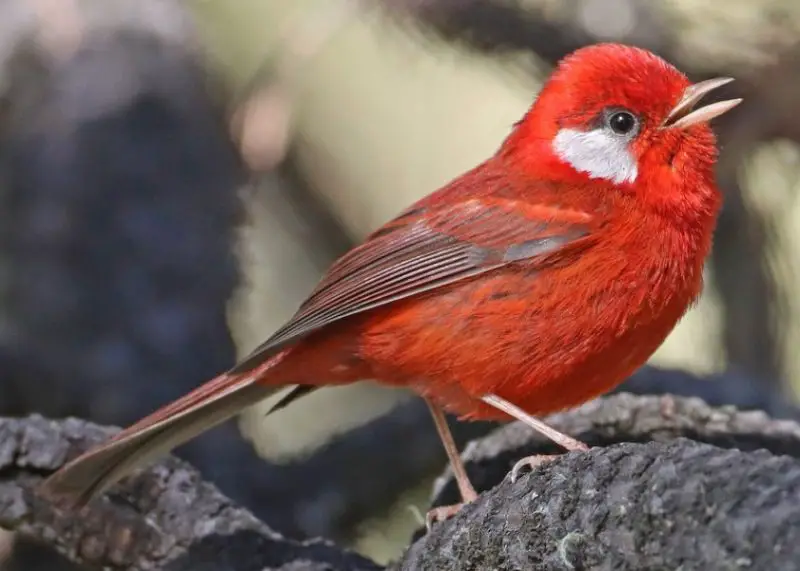
Red Warblers (Cardellina rubra), found mainly in the high-elevation forests of Southern Mexico, display bright red plumage in adulthood, while younger birds often have pink or pink-red feathers.
Adults have dark eye rims, whereas juveniles may have lighter or even white rims. Their wings combine red and black, with red sections closer to the base. Although they are primarily seen in Mexico, a few have been recorded in Southern Texas. These active birds become most noticeable in February during their breeding season.
Scarlet Ibis
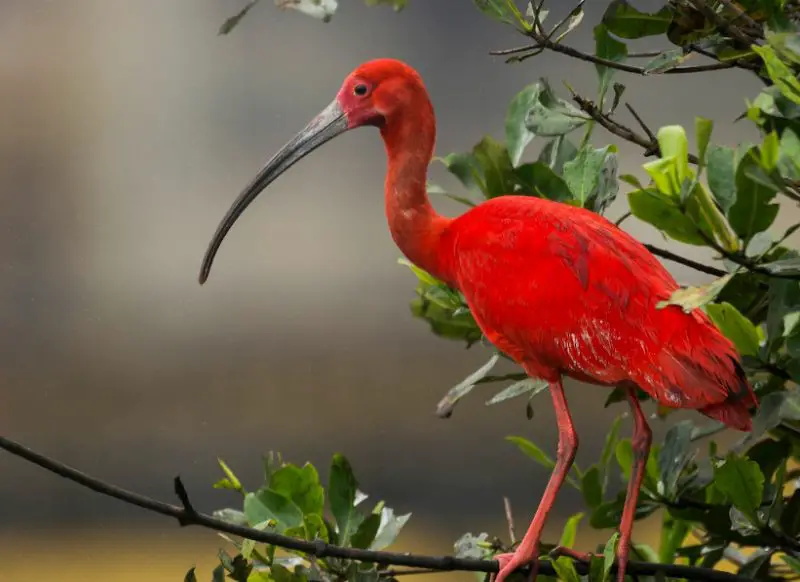
Scarlet Ibises (Eudocimus ruber) are striking shorebirds found along the Atlantic coastline of northeastern South America. Their bright scarlet-red plumage, a mix of red and orange, covers their heads, bellies, and wings. With long, curved black beaks, they are specialized for foraging in mudflats along the shore.
These birds play a crucial ecological role in Brazil’s coastal regions and have been introduced to North America, where small pink morphs are occasionally spotted around Miami. Some interbreed with their white counterparts, creating unique hybrid offspring.
Crimson Rosella
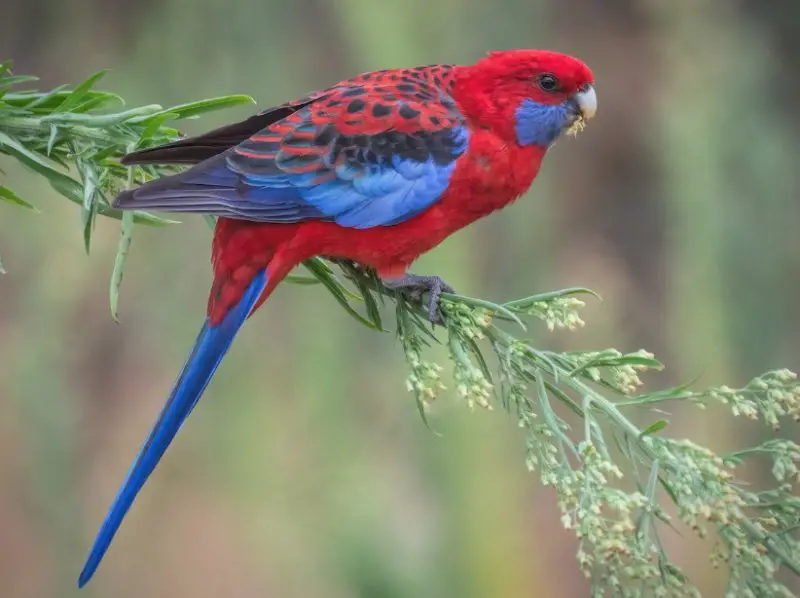
Native to eastern and southeastern Australia, the Crimson Rosella (Platycercus elegans) is a vibrant parrot species known for its crimson-red plumage. Most subspecies of this bird display a red head and underbelly, complemented by a blue neck, black-and-blue wings, and a blue tail.
These parrots are often seen in pairs or small groups and are known for their sedentary nature. Monogamous during the breeding season, they have an unusual ability to distinguish other individuals of their species by scent.
Australian King-Parrot
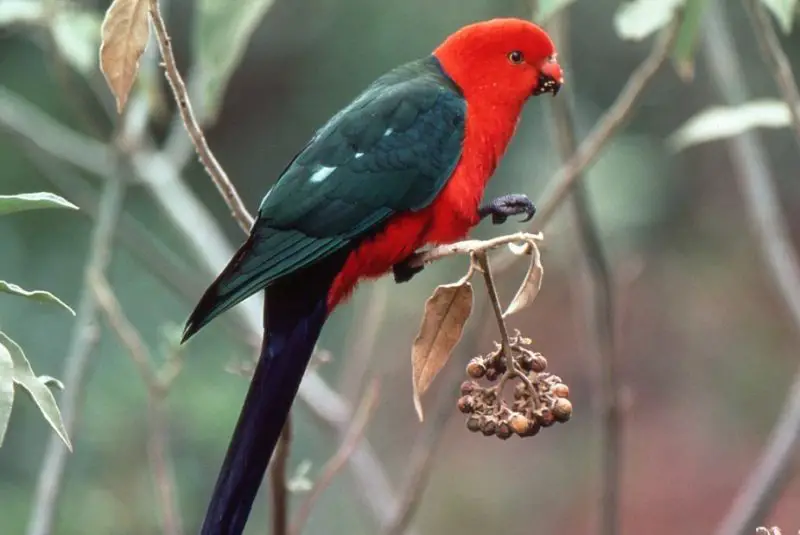
The Australian King-Parrot (Alisterus scapularis), found in eastern Australia, has a bright red head and belly, contrasting with its green back and wings. Males display red heads, while females have green heads, creating a striking difference between the sexes. Juveniles are mostly green with orange-red underbellies.
Often seen in small groups, these parrots share habitats with Crimson Rosellas and other native parrots. Their bright coloration and social nature make them a standout species in Australian forests.

